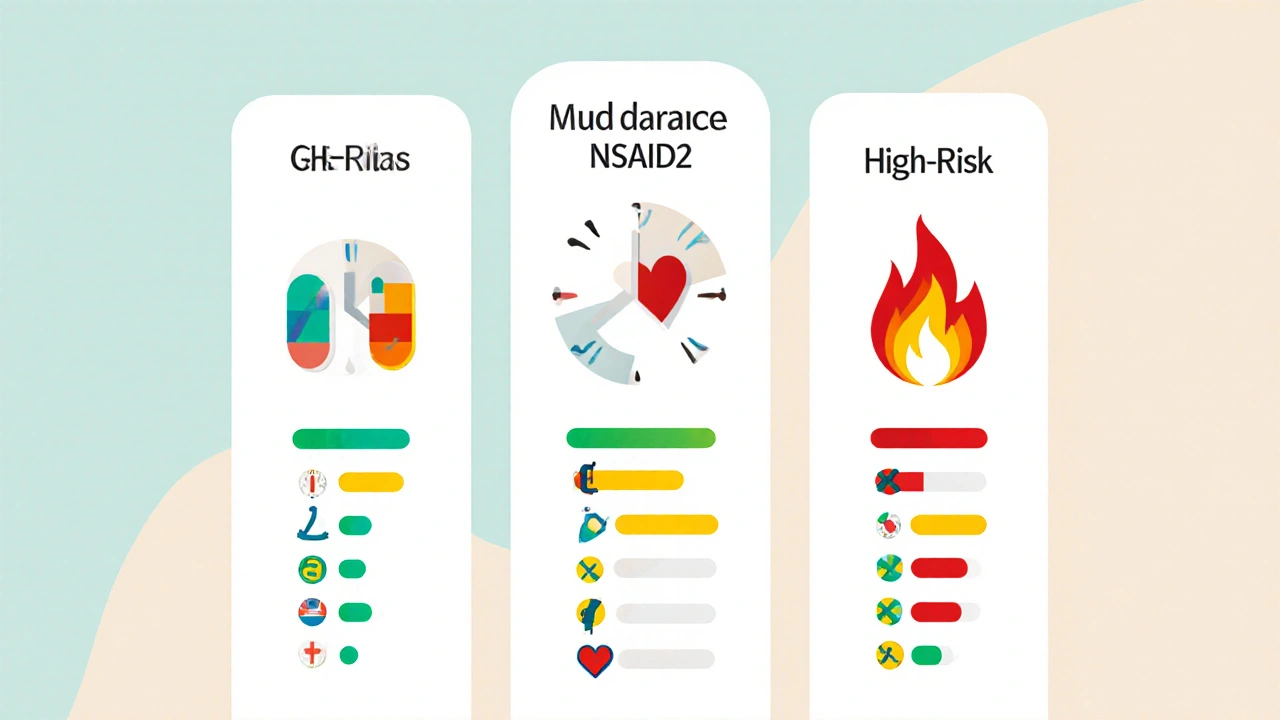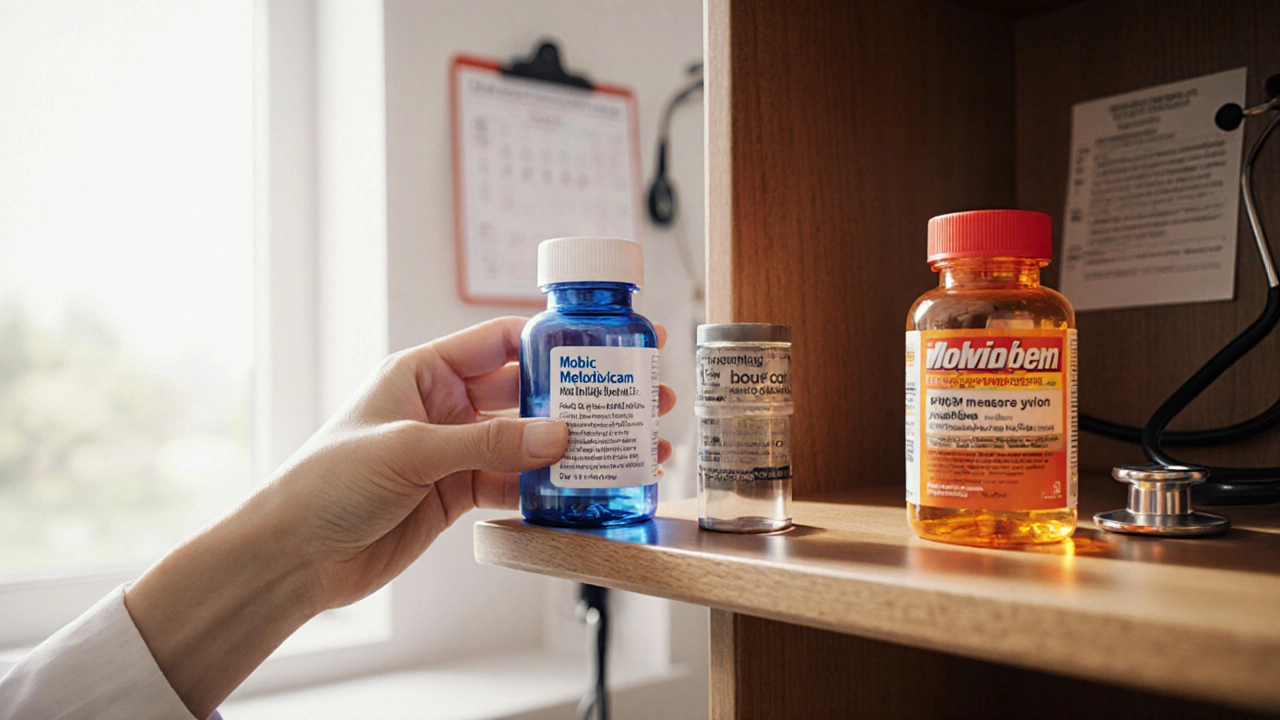NSAID Comparison Tool
Select an NSAID to view detailed comparison information.
- Drug Class: COX-2 selective vs non-selective
- Typical Dose & Frequency: Once daily vs multiple times
- Onset of Relief: How fast pain eases
- Duration of Action: Hours of coverage per dose
- GI Risk: Ulcer or bleeding potential
- CV Risk: Heart-related warnings
- OTC Availability: Over-the-counter vs prescription
When you’re dealing with joint pain or arthritis, the name Mobic (meloxicam) often pops up as a prescription option. But you might wonder whether it’s the best fit or if over‑the‑counter choices could do the job with fewer headaches. This guide breaks down Mobic, weighs it against the most common alternatives, and gives you a clear picture of when each drug shines or falls short.
Quick Summary
- Mobic is a prescription NSAID that leans toward a longer half‑life, making once‑daily dosing convenient.
- Ibuprofen and naproxen are widely available OTC, work quickly but need multiple doses.
- Celecoxib and etoricoxib are COX‑2‑selective, offering lower stomach risk but higher cardiovascular caution.
- Diclofenac, aspirin, and indomethacin stay in the market for specific pain patterns but carry distinct GI and heart profiles.
- Choosing the right NSAID depends on your GI tolerance, cardiovascular health, dosing convenience, and cost.
How Mobic Works and What Sets It Apart
Mobic belongs to the NSAID (non‑steroidal anti‑inflammatory drug) family. It blocks the cyclooxygenase (COX) enzymes, mainly COX‑2, which reduces prostaglandin production - the chemicals that cause inflammation and pain. Meloxicam’s half‑life ranges from 15 to 20 hours, so most patients take it once a day. This steady coverage can be a boon for chronic conditions like osteoarthritis.
Key Criteria for Comparing NSAIDs
To make a fair comparison, consider these factors:
- Drug class - COX‑2 selective vs non‑selective.
- Typical dose and frequency - once daily vs multiple times.
- Onset of relief - how fast pain eases.
- Duration of action - hours of coverage per dose.
- Gastro‑intestinal (GI) risk - ulcer or bleeding potential.
- Cardiovascular (CV) risk - heart‑related warnings.
- Prescription status and cost - OTC availability and price points.
- Common side‑effects - real‑world tolerability.
Popular Alternatives to Mobic
Below are the most frequently mentioned NSAIDs, each introduced with basic attributes.
Celecoxib is a COX‑2‑selective prescription NSAID marketed as Celebrex. It’s popular for patients who need a lower GI‑risk profile but must stay alert to heart‑related warnings.
Ibuprofen is an over‑the‑counter non‑selective NSAID sold under brands like Advil and Nurofen. It works fast, usually within 30minutes, and is a go‑to for mild‑to‑moderate pain.
Naproxen is another OTC NSAID known for its longer half‑life, often seen as Aleve.
Diclofenac is a prescription NSAID that comes in oral, topical, and injectable forms.
Aspirin is a historic NSAID used in low doses for heart protection and higher doses for pain.
Etoricoxib is a newer COX‑2‑selective NSAID mainly prescribed outside the United States.
Indomethacin is a potent NSAID often reserved for gout or severe arthritis flares.

Side‑by‑Side Comparison Table
| Drug | Class | Typical Dose | Onset | Duration | GI Risk | CV Risk | OTC? |
|---|---|---|---|---|---|---|---|
| Mobic (Meloxicam) | Non‑selective (COX‑2‑preferential) | 7.5‑15mg once daily | 1‑2hrs | ≈24hrs | Moderate | Elevated (especially in >65y) | No |
| Celecoxib | COX‑2‑selective | 100‑200mg once daily | 1‑2hrs | ≈12‑24hrs | Low | Higher (thrombotic) | No |
| Ibuprofen | Non‑selective | 200‑400mg every 4‑6hrs | ≈30min | ≈4‑6hrs | Moderate‑High | Moderate | Yes |
| Naproxen | Non‑selective | 220‑440mg every 8‑12hrs | ≈1hr | ≈12‑15hrs | Moderate | Low‑Moderate | Yes |
| Diclofenac | Non‑selective | 50‑75mg 2‑3×/day | ≈30‑60min | ≈6‑8hrs | High | High | No |
| Aspirin (high‑dose) | Non‑selective | 325‑650mg every 4‑6hrs | ≈30‑45min | ≈4‑6hrs | High | Low (low‑dose) / High (high‑dose) | Yes |
| Etoricoxib | COX‑2‑selective | 60‑120mg once daily | ≈1‑2hrs | ≈24hrs | Low | High | No |
| Indomethacin | Non‑selective | 25‑50mg 2‑3×/day | ≈30‑45min | ≈4‑6hrs | High | Moderate‑High | No |
When Mobic Might Be the Right Choice
If you need a medication that you can take once daily without juggling multiple doses, Mobic’s long half‑life is attractive. It’s especially useful for:
- Chronic osteoarthritis where steady inflammation control matters.
- Patients who have difficulty remembering multiple daily pills.
- Those who have tried ibuprofen or naproxen but experienced breakthrough pain before the next dose.
However, the trade‑off is a moderate GI risk and a warning for people over 65 with heart disease. If you fall into that category, a COX‑2‑selective option like celecoxib might feel safer for your stomach, but you’ll need to discuss cardiovascular monitoring with your doctor.
Best Alternatives for Specific Situations
Fast, occasional pain - Reach for ibuprofen or naproxen. They act within an hour, are cheap, and you can buy them without a script. For a short‑term sports injury, a 200‑mg ibuprofen tablet every 4‑6hours works well.
Stomach‑sensitive patients - Celecoxib or etoricoxib provide comparable pain relief while sparing the lining. Keep in mind the heart warning: if you have a history of clotting disorders, discuss alternatives.
Severe gout attacks - Indomethacin remains a first‑line choice because it hits the inflammation hard and fast. Pair it with colchicine if the flare is extreme.
Topical need - Diclofenac gel can be applied directly to joints, delivering local relief with reduced systemic exposure. It’s a good adjunct for hand or knee osteoarthritis.
Low‑dose heart protection - Aspirin at 81mg daily is not a pain reliever but a cardiovascular safeguard. If you need both pain control and heart protection, a combination approach (low‑dose aspirin plus an NSAID) should only be done under physician guidance.
Safety Tips and Common Pitfalls
Regardless of which NSAID you pick, follow these rules:
- Take the lowest effective dose for the shortest time needed.
- Never mix two non‑selective NSAIDs (e.g., ibuprofen + naproxen) - the GI risk spikes.
- If you have a history of ulcers, add a proton‑pump inhibitor (omeprazole) or choose a COX‑2‑selective drug.
- Stay hydrated and avoid alcohol while on any NSAID.
- Watch for warning signs: stomach pain, black stools, sudden swelling, or chest pain. Seek medical help immediately.
For chronic users, schedule routine labs (Kidney function, liver enzymes) every 3‑6months. This catches silent toxicity before it becomes serious.
Frequently Asked Questions
Can I take Mobic with ibuprofen for extra pain relief?
No. Combining two NSAIDs adds up their GI and kidney risks without giving extra pain control. If one drug isn’t enough, talk to a doctor about switching or adding a different class, such as acetaminophen.
Is Mobic safe for people with high blood pressure?
Mobic can raise blood pressure, especially in high‑dose or long‑term use. If you already have hypertension, a doctor may prefer a COX‑2‑selective drug or a lower NSAID dose plus close monitoring.
How quickly does Mobic start working?
Pain relief usually begins within 1‑2hours, but the anti‑inflammatory effect can take several days of consistent dosing.
Can I use Mobic if I’m pregnant?
Mobic is classified as Pregnancy Category C - it should be avoided unless the benefits outweigh the risks. Safer alternatives during pregnancy are usually acetaminophen or prescribed low‑dose aspirin under strict medical supervision.
What’s the cost difference between Mobic and OTC options?
Mobic costs around $30‑$50 for a 30‑day supply without insurance, while ibuprofen or naproxen can be $5‑$15 for the same period. Insurance coverage can bring the prescription price down dramatically, though co‑pays vary.

Bottom Line: Pick the NSAID That Matches Your Priorities
There’s no one‑size‑fits‑all answer. If you value once‑daily dosing and have a relatively low GI risk, Mobic comparison points you toward meloxicam. If your stomach is sensitive or you have heart concerns, consider celecoxib or naproxen. For occasional aches where cost matters, reach for ibuprofen or naproxen OTC. Always discuss your health history with a pharmacist or doctor before starting a new NSAID, especially if you take blood thinners, have kidney disease, or are over 65.





Brooklyn Andrews
October 5, 2025 AT 16:56Gina Damiano
October 6, 2025 AT 12:03Sean Nhung
October 7, 2025 AT 19:02Stacey Whitaker
October 9, 2025 AT 10:47kat pur
October 10, 2025 AT 01:49Stephen Tolero
October 11, 2025 AT 17:07Kayleigh Walton
October 12, 2025 AT 11:26Vatsal Nathwani
October 12, 2025 AT 22:34Emily Duke
October 13, 2025 AT 06:02Saloni Khobragade
October 14, 2025 AT 13:29Shanna Talley
October 15, 2025 AT 20:04Joanne Haselden
October 17, 2025 AT 16:54Vivek Mishra
October 18, 2025 AT 03:53